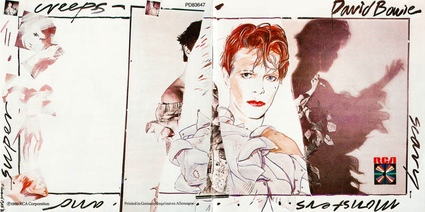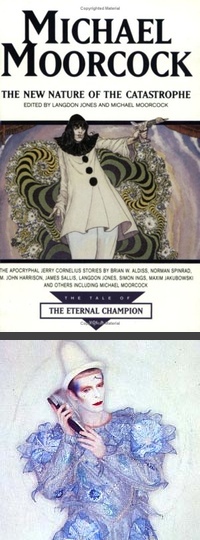Do you remember a guy that’s been
In such an early song
So asks David Bowie at the beginning of “Ashes to Ashes.” That guy, of course, is Major Tom, the lost astronaut hero of “Space Oddity,” and when Scary Monsters was released in 1980, much had changed in the 11 years since the major had originally gone floating ’round his tin can.
1980: the beginning of the Me Decade. Bowie might have been announcing its arrival in his song “Up the Hill Backwards”: “the vacuum created by the arrival of freedom.” Ronald Reagan was elected that year, and Margaret Thatcher had been Prime Minister of Great Britain for a year. Ridley Scott had just released Alien the year before, and he was two years away from Blade Runner. AIDS had not yet entered public consciousness; its emergence was a year away. Look back at 1980 with the clarity of hindsight and you’ll find dark currents under bright colors: a tangle of ideological warfare, Cold War anxiety, dystopian murmurings, hints of looming doom behind photogenic smiles.
Enter Scary Monsters.

By this time Bowie had been through the drug-fueled wringer that brought about Station to Station, and the European sojourn that produced Low, Heroes, and Lodger. Ziggy Stardust, the other great Bowie spaceman, was long since dead and buried. Bowie had become a kind of elder statesman in the world of popular music—he’d been around long enough to be an influence on post-punk and New Wave. Now he sang about the youngsters who would “take me aside, and say / ‘Well David, what shall I do? / They wait for me in the hallway'” and lamented that he was no longer “some piece of teenage wildlife.” Scary Monsters is a valediction to the 1970s, a turning point in Bowie’s career, and by many critical yardsticks, his last “great” album.
It’s also science fiction, though it’s not the science fiction of “Space Oddity,” “Ziggy Stardust,” or even “Five Years.” Here we find the dystopian near-future of “Scream Like a Baby,” where a police state “came down hard on the faggots took away our clothes and things / Pumped us full of strange drugs.” Back in the Ziggy Stardust days, even the elegiac “Five Years” had something transcendent in the singer’s hunger to cling to and immortalize all of his life’s experiences in the face of certain death; there is no such transcendence to be found in Scary Monsters. The children who might have lost it, used it, and boogied in “Starman” are now are now “war-torn and resigned” in “Because You’re Young,” and the streets are full of burnout cases like the corrupting narrator of “Scary Monsters (And Super Creeps)” and his damaged lover: “stupid in the streets and she can’t socialise.” Where once dressing up was liberation and freedom of expression, fashion now arrives with the “goon squad” in strict formation; you can practically see the shoulder pads and knife pleats, a very stylish army.
The wistful lost spaceman Major Tom is revealed as the pathetic subject of a twisted little children’s rhyme: “Ashes to ashes, funk to funky / we know Major Tom’s a junky / strung out on heaven’s high / feeling an all-time low.” It’s the end of optimism; cynicism and irony are the order of the day. Tom Ewing is right on the money when he writes, “So Major Tom thought he was starring in an Arthur C. Clarke story and found himself in a Philip K. Dick one by mistake, and the result is oddly magnificent.”
Scary Monsters is David Bowie as cyberpunk. These days, that word sounds dreadfully dated, but it’s helpful to remember what it was like when it was new and exciting. It felt spiky and original: that gritty sense of street-level technology, informed by a culture where computers could now be personal, no longer just a tool for lab-coated scientists, and by an increasingly global sensibility then dominated by an ascendant Japan. On Scary Monsters, the rise of a high-tech, de-Orientalized Japan is embodied in the knife-sharp spoken word delivered by actress Michi Hirota in “It’s No Game.” Even to a non-speaker of Japanese, there’s something disorienting and unexpected about her delivery; in his post on this song in his excellent blog Pushing Ahead of the Dame, Chris O’Leary points out that Hirota’s delivery and use of pronouns is specifically masculine, purposely contrary to Western stereotypes of Japanese femininity. Something new is happening here, underlined later by the dramatic guitars and synths laced throughout the album, the barking bass sounds in “Scary Monsters (And Super Creeps),” and the distorted vocals of “Scream Like a Baby.”
 Scary Monsters is also New Wave Bowie, but not so much the music style as the British New Wave of science fiction, as defined by the alienated urban sensibilities of J.G. Ballard and the druggy visions of Michael Moorcock’s Jerry Cornelius—a character who, like Bowie on the cover of Scary Monsters, often appears in Pierrot drag. In contrast to Hirota’s voice from the future, Bowie in his delicate, frayed-looking Pierrot costume approaches androgyny from the other direction. Which at first glance couldn’t be any less science-fictional or cyberpunk, but look at it through the filter provided by the haunting, stark video for “Ashes to Ashes,” where it manages to suggest something both nostalgic and alien—prefiguring, however unintentionally, J.F. Sebastian’s workshop in Blade Runner.
Scary Monsters is also New Wave Bowie, but not so much the music style as the British New Wave of science fiction, as defined by the alienated urban sensibilities of J.G. Ballard and the druggy visions of Michael Moorcock’s Jerry Cornelius—a character who, like Bowie on the cover of Scary Monsters, often appears in Pierrot drag. In contrast to Hirota’s voice from the future, Bowie in his delicate, frayed-looking Pierrot costume approaches androgyny from the other direction. Which at first glance couldn’t be any less science-fictional or cyberpunk, but look at it through the filter provided by the haunting, stark video for “Ashes to Ashes,” where it manages to suggest something both nostalgic and alien—prefiguring, however unintentionally, J.F. Sebastian’s workshop in Blade Runner.
In that video (reportedly the most expensive music video made to date), interspersed with Pierrot-Bowie and his sacerdotal Blitz Kids attendants, are flashes of Bowie in a padded cell, trapped in a space suit in an exploding 1950s kitchen, and suspended in an Alien-like chamber among tentacled tubing. A hallucinatory 1980 science-fiction moment if there ever was one.
Caught in the grip of rising future-shock, a state that William Gibson will later observe is a near-permanent condition of the early twenty-first century, Bowie doesn’t so much sing here as he screams, howls, chants, growls, and croons. The high notes have rarely sounded more desperate, the depths more world-weary. Scary Monsters is still the sound of a spaceman: one who fell to Earth with a crash years ago and, ever more lost and overwhelmed, is coming to grips with a darker, more unpredictable future than he could have possibly imagined.
Karin Kross lives and writes in Austin, TX. She will be forever grateful that she was lucky enough to see David Bowie on the Reality tour. She can be found elsewhere on Tumblr and Twitter.









